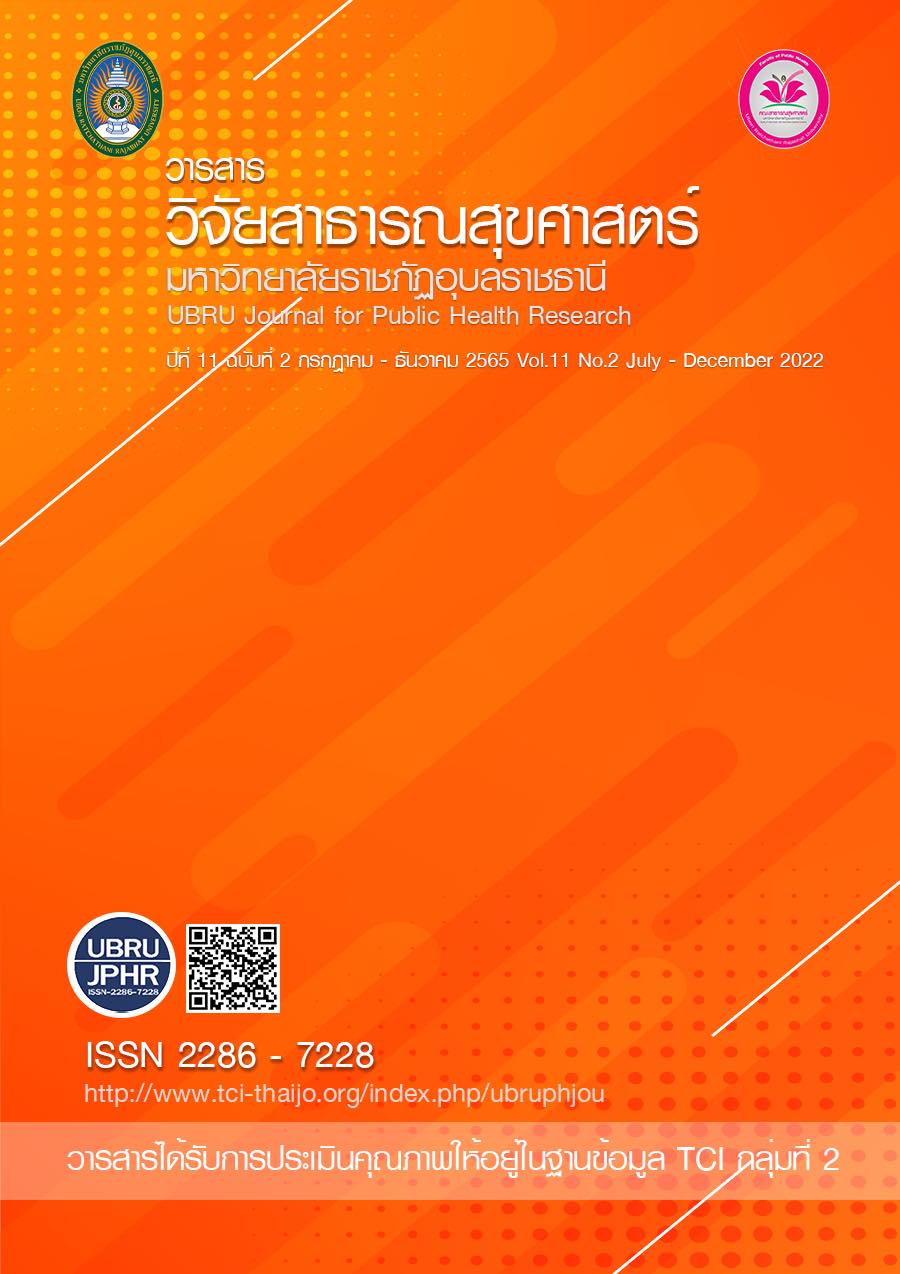Risk factors of carbapenem-resistant enterobacteriaceae infection
Keywords:
Nosocomial infection, carbapenem-resistant Enterobacterales, EnterobacteriaceaeAbstract
This Study to determine risk factor associated with carbapenem-resistant Enterobacteriaceae (CRE) in patients who admitted at Roi Et hospital. The objective of this study was to investigate risk factors of Carbapenem-Resistant Enterobacterales(CRE) infection in patients at Roi Et hospital.
Method: Study design was case-control by divide into CRE-infected patients (case; n=192), carbapenem-susceptible Enterobacteriaceae (CSE) infected patients (control; n=192). Data of these patients were collected during January 1-December 31, 2018.
Result: the study revealed that most of patients in case group was male (57.3%) and age- mean of 62-year-old (SD=16.67), hospitalization more than 7 days (54.7%). Both control group showed (65.1%), age-mean of 64-year-old (S.D.=13.42), and hospitalization more than 7days (59.9%), respectively. Analysis comparison among case and control group demonstrated that male (ORAdj=2.35, 95%CI=1.76-3.14), age >60 year-old (ORAdj=2.35,95%CI =1.76-3.14), hospitalization >7 days (ORA dj=2.00,95%CI=1.50-2.66), received carbapenem before admit (ORAdj=3.31, 95%CI =2.46-4.46), received carbapenem during hospitalization (ORAdj=3.69, 95%CI=2.74-4.98), blood received (ORAdj= 2.52,95%CI= 1.88-3.38), ventilation association (ORAdj=2.64, 95%CI=1.97-3.54), ventilation used >7days (ORAdj=3.38,95%CI=2.43-4.71), surgery (ORAdj=2.20;95%CI:1.61-3.02), intravenous injection (ORAdj=4.19;95%CI:3.10-5.66), and >7 days (ORAdj =3.50;95% CI:2.53-4.86), utilization of urinary catheter (ORAdj=2.26,95%CI=1.68-3.02), and>7days (ORAdj=3.60,95%CI =2.57-5.05) were the risk factors of CRE infection.
Conclusions: This study found out that risk factors of CRE infection were Carbapenems treatment, underwent with ventilation, catheterization, blood transfusion, surgery, Central Venous Catheter, and utilization of urinary catheter.
References
Ambler, R. P. (1980). The structure of beta-lactamases. Philosophical Transactions of the Royal Society of London. Series B, Biological Sciences, 289(1036), 321–331. https://doi.org/10.1098/rstb.1980.0049
Baran, I., & Aksu, N. (2016). Phenotypic and genotypic characteristics of carbapenem-resistant Enterobacteriaceae in a tertiary-level reference hospital in Turkey. Annals of Clinical Microbiology and Antimicrobials, 15, 20. https://doi.org/10.1186/s12941-016-0136-2
Bush, K., & Fisher, J. F. (2011). Epidemiological expansion, structural studies, and clinical challenges of new β-lactamases from gram-negative bacteria. Annual Review of Microbiology, 65, 455–478. https://doi.org/10.1146/annurev-micro-090110-102911
Demir, Y., Zer, Y., & Karaoglan, I. (2015). Investigation of VIM, IMP, NDM-1, KPC AND OXA-48 enzymes in Enterobacteriaceae strains. Pakistan Journal of Pharmaceutical Sciences, 28(3 Suppl), 1127–1133.
Dhar, S., Martin, E. T., Lephart, P. R., McRoberts, J. P., Chopra, T., Burger, T. T., Tal-Jasper, R., Hayakawa, K., Ofer-Friedman, H., Lazarovitch, T., Zaidenstein, R., Perez, F., Bonomo, R. A., Kaye, K. S., & Marchaim, D. (2016). Risk Factors and Outcomes for Carbapenem-Resistant Klebsiella pneumoniae Isolation, Stratified by Its Multilocus Sequence Typing: ST258 Versus Non-ST258. Open Forum Infectious Diseases, 3(1), ofv213. https://doi.org/10.1093/ofid/ofv213
Doyle, D., Peirano, G., Lascols, C., Lloyd, T., Church, D. L., & Pitout, J. D. D. (2012). Laboratory Detection of Enterobacteriaceae That Produce Carbapenemases. Journal of Clinical Microbiology, 50(12), 3877–3880. https://doi.org/10.1128/JCM.02117-12
Guh, A. Y., Bulens, S. N., Mu, Y., Jacob, J. T., Reno, J., Scott, J., Wilson, L. E., Vaeth, E., Lynfield, R., Shaw, K. M., Vagnone, P. M. S., Bamberg, W. M., Janelle, S. J., Dumyati, G., Concannon, C., Beldavs, Z., Cunningham, M., Cassidy, P. M., Phipps, E. C., … Kallen, A. J. (2015). Epidemiology of Carbapenem-Resistant Enterobacteriaceae in 7 US Communities, 2012-2013. JAMA, 314(14), 1479–1487. https://doi.org/10.1001/jama.2015.12480
Hammoudi, D., Moubareck, C. A., Kanso, A., Nordmann, P., & Sarkis, D. K. (2015). SURVEILLANCE of CARBAPENEM NON-SUSCEPTIBLE GRAM NEGATIVE STRAINS and CHARACTERIZATION of CARBAPENEMASES of CLASSES A, B and D in a LEBANESE HOSPITAL. Le Journal Medical Libanais. The Lebanese Medical Journal, 63(2), 66–73. https://doi.org/10.12816/0012553
Hamzan, N. I., Yean, C. Y., Rahman, R. A., Hasan, H., & Rahman, Z. A. (2015). Detection of blaIMP4 and blaNDM1 harboring Klebsiella pneumoniae isolates in a university hospital in Malaysia. Emerging Health Threats Journal, 8, 10.3402/ehtj.v8.26011. https://doi.org/10.3402/ehtj.v8.26011
Karabay, O., Altindis, M., Koroglu, M., Karatuna, O., Aydemir, Ö. A., & Erdem, A. F. (2016). The carbapenem-resistant Enterobacteriaceae threat is growing: NDM-1 epidemic at a training hospital in Turkey. Annals of Clinical Microbiology and Antimicrobials, 15, 6. https://doi.org/10.1186/s12941-016-0118-4
Logan, L. K., & Weinstein, R. A. (2017). The Epidemiology of Carbapenem-Resistant Enterobacteriaceae: The Impact and Evolution of a Global Menace. The Journal of Infectious Diseases, 215(Suppl 1), S28–S36. https://doi.org/10.1093/infdis/jiw282
Nordmann, P., Cuzon, G., & Naas, T. (2009). The real threat of Klebsiella pneumoniae carbapenemase-producing bacteria. The Lancet. Infectious Diseases, 9(4), 228–236. https://doi.org/10.1016/S1473-3099(09)70054-4
Nordmann, P., Naas, T., & Poirel, L. (2011). Global spread of Carbapenemase-producing Enterobacteriaceae. Emerging Infectious Diseases, 17(10), 1791–1798. https://doi.org/10.3201/eid1710.110655
Patel, G., & Bonomo, R. A. (2013). “Stormy waters ahead”: Global emergence of carbapenemases. Frontiers in Microbiology, 4, 48. https://doi.org/10.3389/fmicb.2013.00048
Schwaber, M. J., & Carmeli, Y. (2008). Carbapenem-resistant Enterobacteriaceae: A potential threat. JAMA, 300(24), 2911–2913. https://doi.org/10.1001/jama.2008.896
Siegel, J. D., Rhinehart, E., Jackson, M., & Chiarello, L. (2007). 2007 Guideline for Isolation Precautions: Preventing Transmission of Infectious Agents in Health Care Settings. American Journal of Infection Control, 35(10), S65–S164. https://doi.org/10.1016/j.ajic.2007.10.007
Thomson, J. M., & Bonomo, R. A. (2005). The threat of antibiotic resistance in Gram-negative pathogenic bacteria: Beta-lactams in peril. Current Opinion in Microbiology, 8(5), 518–524. https://doi.org/10.1016/j.mib.2005.08.014
van Duin, D., & Doi, Y. (2017). The global epidemiology of carbapenemase-producing Enterobacteriaceae. Virulence, 8(4), 460–469. https://doi.org/10.1080/21505594.2016.1222343
van Duin, D., Perez, F., Rudin, S. D., Cober, E., Hanrahan, J., Ziegler, J., Webber, R., Fox, J., Mason, P., Richter, S. S., Cline, M., Hall, G. S., Kaye, K. S., Jacobs, M. R., Kalayjian, R. C., Salata, R. A., Segre, J. A., Conlan, S., Evans, S., … Bonomo, R. A. (2014). Surveillance of Carbapenem-Resistant Klebsiella pneumoniae: Tracking Molecular Epidemiology and Outcomes through a Regional Network. Antimicrobial Agents and Chemotherapy, 58(7), 4035–4041. https://doi.org/10.1128/AAC.02636-14
Wang, J.-T., Wu, U.-I., Lauderdale, T.-L. Y., Chen, M.-C., Li, S.-Y., Hsu, L.-Y., & Chang, S.-C. (2015). Carbapenem-Nonsusceptible Enterobacteriaceae in Taiwan. PLoS ONE, 10(3), e0121668. https://doi.org/10.1371/journal.pone.0121668
Wang, X., Chen, G., Wu, X., Wang, L., Cai, J., Chan, E. W., Chen, S., & Zhang, R. (2015). Increased prevalence of carbapenem resistant Enterobacteriaceae in hospital setting due to cross-species transmission of the blaNDM-1 element and clonal spread of progenitor resistant strains. Frontiers in Microbiology, 6, 595. https://doi.org/10.3389/fmicb.2015.00595
Downloads
Published
How to Cite
Issue
Section
License
Copyright (c) 2022 คณะสาธารณสุขศาสตร์ มหาวิทยาลัยราชภัฏอุบลราชธานี

This work is licensed under a Creative Commons Attribution-NonCommercial-NoDerivatives 4.0 International License.
เนื้อหาและข้อมูลในบทความที่ลงตีพิมพ์ในวารสารวารสารวิจัยสาธารณสุขศาสตร์ มหาวิทยาลัยราชภัฏอุบลราชธานี ถือเป็นข้อคิดเห็นและความรับผิดชอบของผู้เขียนบทความโดยตรงซึ่งกองบรรณาธิการวารสาร ไม่จำเป็นต้องเห็นด้วย หรือร่วมรับผิดชอบใดๆ
บทความ ข้อมูล เนื้อหา รูปภาพ ฯลฯ ที่ได้รับการตีพิมพ์ในวารสารนี้ ถือเป็นลิขสิทธิ์ของวารสารฯ หากบุคคลหรือหน่วยงานใดต้องการนำทั้งหมดหรือส่วนหนึ่งส่วนใดไปเผยแพร่ต่อหรือเพื่อกระทำการใดๆ จะต้องได้รับอนุญาตเป็นลายลักอักษรณ์จากบรรณาธิการวารสารนี้ก่อนเท่านั้น


